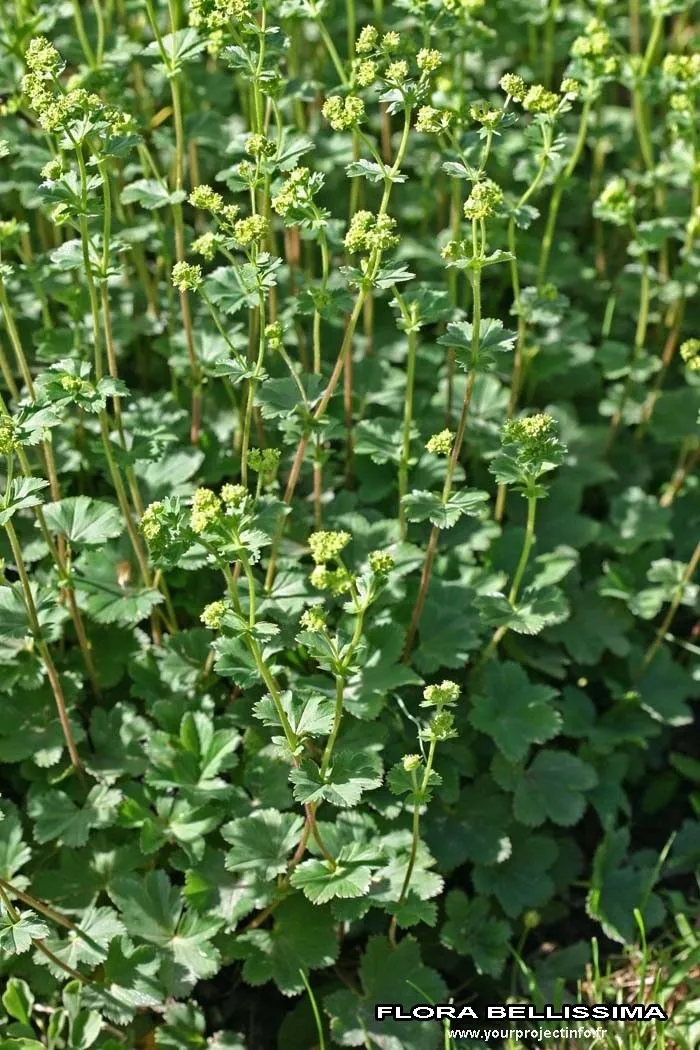
Author: Wallr.
Bibliography: ; 1840, 134, 1840
Year: 1840
Status: accepted
Rank: species
Genus: Alchemilla
Vegetable: False
Observations: Europe
The Silky Lady’s Mantle, known scientifically as Alchemilla glaucescens, is a noteworthy member of the Rosaceae family. This plant was first described in detail by Wallr. in 1840. Found predominantly across Europe, the Silky Lady’s Mantle has captivated botanists and horticulturists alike with its distinct characteristics and ecological importance.
Characterized by its soft, velvety leaves, the Silky Lady’s Mantle is adorned with a beautiful greyish-green (glaucous) hue, distinguishing it from other members of the Alchemilla genus. The foliage forms a low, compact mound, making it an excellent ground cover in gardens and natural landscapes. The leaves are typically lobed, with a delicate texture that lives up to the ‘silky’ descriptor in its common name.
In early to mid-summer, Alchemilla glaucescens produces small, chartreuse flowers arranged in loose clusters. Although individually modest, the collective bloom creates a subtle, yet visually appealing display. These flowers not only add aesthetic value but also support local ecosystems by attracting a variety of pollinators, including bees and other beneficial insects.
Ecologically, the Silky Lady’s Mantle thrives in well-drained soils and can often be found growing in meadows, grasslands, and mountainous regions across Europe. Its hardiness and adaptability make it suitable for different gardening environments, from rock gardens to perennial borders.
The resilience and low-maintenance nature of Alchemilla glaucescens make it a popular choice for gardeners seeking to create sustainable and wildlife-friendly garden spaces. Furthermore, its foliage retains morning dew, giving it a sparkling appearance in the early sunlight – a feature that has enchanted plant enthusiasts for generations.
Throughout history, the Silky Lady’s Mantle has also been utilized for its purported medicinal properties. Traditional uses include applications for wound healing and other herbal remedies, although modern scientific validation of these uses remains limited.
In summary, Alchemilla glaucescens, or the Silky Lady’s Mantle, is a perennial plant that offers a blend of aesthetic charm and ecological benefits. Its historical significance, ease of cultivation, and role in supporting biodiversity underscore its value within the botanical world and beyond.
Deu: bastard-frauenmantel, blaugrüner frauenmantel, „bastard”-frauenmantel
Dan: blågrøn løvefod
Nob: fløyelsmarikåpe
Nno: fløyelsmarikåpe
Swe: harmaapoimulehti, sammetsdaggkåpa
Fin: harmaapoimulehti
Nld: blauwgroene vrouwenmantel
Fra: alchémille bleuâtre, alchémille glauque, alchémille pubescente
Sme: ránesvuolpu
Eng: silky lady’s mantle, waxy lady’s mantle
En: Silky lady’s mantle, Waxy lady’s mantle, Lady’s-mantle [Alchemilla glaucescens]
Bg: Сивосинкаво шапиче
Cs: Kontryhel sivý
Da: Blågrøn løvefod
Nl: Blauwgroene vrouwenmantel
Et: Väike kortsleht
Fi: Harmaapoimulehti
Fr: Alchémille bleuâtre, Alchémille glauque, Alchémille pubescente
De: Blaugrüner Frauenmantel, Filziger Frauenmantel, Bastard-Frauenmantel, „Bastard”-Frauenmantel, Filz-Frauenmantel, Weichhaariger Frauenmantel
Hu: Hegyi palástfű
It: Alchemilla ibride, Ventaglina ibride
Se: Ránesvuolpu
Nb: Fløyelsmarikåpe
Nn: Fløyelsmarikåpe
Sv: Harmaapoimulehti, Sammetsdaggkåpa
Uk: Приворотень сизуватий
Taken Jun 9, 2020 by Kadlecová Alena (cc-by-sa)
Taken Apr 13, 2020 by Claude BOULOMMIER (cc-by-sa)
Taken May 8, 2022 by geraldine tagger (cc-by-sa)
Taken Apr 14, 2020 by Lorence Chapron (cc-by-sa)
Taken Jan 1, 1800 by Tela Botanica − Thierry Pernot (cc-by-sa)
Taken Jun 2, 2018 by Klaus Petersen (cc-by-sa)
Taken May 4, 2020 by André Kovács (cc-by-sa)
Taken May 26, 2022 by Sylwia Bochenko (cc-by-sa)
Taken Apr 27, 2020 by Michaěa Šalandová (cc-by-sa)
Taken Jan 1, 1800 by Tela Botanica − Thierry Pernot (cc-by-sa)
Taken Jul 15, 2011 by Photoflora – Benoit BOCK (©)
Taken Jul 15, 2011 by Photoflora – Jean-Luc TASSET (©)
Taken Jul 15, 2017 by Photoflora – Jean-Luc TASSET (©)
Taken Jul 15, 2017 by Photoflora – Jean-Luc TASSET (©)
Taken Jan 1, 1800 by Tela Botanica − Thierry Pernot (cc-by-sa)
Taken Jul 15, 2011 by Photoflora – Benoit BOCK (©)
Taken Jul 15, 2011 by Photoflora – Benoit BOCK (©)
Taken Jan 1, 1970 by Photoflora – L’Abbé COSTE (©)
Taken Jan 1, 1800 by Tela Botanica − Thierry Pernot (cc-by-sa)
© copyright of the Board of Trustees of the Royal Botanic Gardens, Kew.
Ph maximum: 5.5
Ph minimum: 5.0
Light: 7
Atmospheric humidity: 6
Bloom months: [‘jun’, ‘jul’, ‘aug’]
Soil nutriments: 3
Family: Myrtaceae Author: (F.Muell.) K.D.Hill & L.A.S.Johnson Bibliography: Telopea 6: 402 (1995) Year: 1995 Status:…
Family: Rubiaceae Author: Pierre ex A.Froehner Bibliography: Notizbl. Bot. Gart. Berlin-Dahlem 1: 237 (1897) Year:…
Family: Sapindaceae Author: Koidz. Bibliography: J. Coll. Sci. Imp. Univ. Tokyo 32(1): 38 (1911) Year:…
Family: Asteraceae Author: A.Gray Bibliography: Pacif. Railr. Rep.: 107 (1857) Year: 1857 Status: accepted Rank:…
Family: Fabaceae Author: Medik. Bibliography: Vorles. Churpfälz. Phys.-Ökon. Ges. 2: 398 (1787) Year: 1787 Status:…
Family: Aspleniaceae Author: (Cav.) Alston Bibliography: Bull. Misc. Inform. Kew 1932: 309 (1932) Year: 1932…